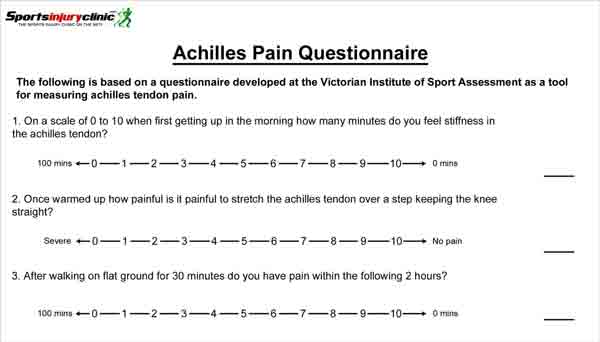Achilles tendonitis refers to an overuse injury, marked by pain at the back of the ankle. Early detection aids ineffective treatment. Delayed intervention can complicate the healing process.
Achilles tendonitis symptoms & diagnosis
Achilles tendonitis manifests as either acute or chronic. Acute symptoms surface over several days and, without appropriate treatment, can transition into a chronic condition.
Acute symptoms:
- Pain and stiffness in the Achilles tendon, particularly noticeable in the morning or after rest.
- The discomfort tends to decrease as the tendon warms up but may recur later.
- Tenderness is felt when pressing in or squeezing from the sides of the tendon.
- Some individuals may detect a nodule or lump in the middle of the tendon.
Chronic symptoms:
- Gradual development of pain over weeks or months.
- Increased discomfort experienced during exercise.
- Pain while walking, particularly uphill or upstairs.
- Persistent Achilles pain may not fully hinder activity but can impact performance.
- Prolonged neglect may escalate the risk of a total Achilles rupture.
Imaging
An MRI or Ultrasound scan accurately determines the injury’s extent and provides a precise diagnosis.
How bad is my Achilles tendonitis?
The VISA Achilles tendon pain questionnaire (download PDF) assesses the severity of your injury. By answering a few questions, you can obtain a score out of 100, offering an effective method to track your progress.

What is Achilles tendonitis?
Achilles tendonitis, Achilles tendinopathy, or Achilles tendinosis is an overuse injury that causes pain, inflammation, or degeneration of the Achilles tendon.
Situated at the back of the ankle, the Achilles tendon is a large, thick band of tissue connecting the calf muscles to the back of the heel. It undergoes significant strain from the forces generated during walking and running.
Tendonitis or tendinopathy?
Tendonitis, indicated by the suffix ‘-itis’ meaning inflammation, is often thought to be the cause of tendon injuries. However, in reality, these injuries usually involve more than just inflammation.
Especially in older athletes, the primary finding is often tendon degeneration, essentially wear and tear. Consequently, the term tendinopathy is more suitable for describing the various conditions that can lead to Achilles pain. Studies reveal that chronic injuries typically lack acute inflammatory cells.
Another Achilles injury with similar symptoms is tenosynovitis, which involves inflammation of the sheath surrounding the Achilles tendon.
Causes
Causes of Achilles Tendon Injury are:
Poor foot biomechanics: Overpronation leads to excessive foot rolling, causing your Achilles tendon to twist and become more susceptible to overuse injury.
Incorrect footwear: Ensure you select appropriate running shoes that match your foot type and sport. Worn-out or insufficiently supportive shoes can strain your Achilles tendon.
Wearing high heels: Regularly wearing high heels results in adaptive shortening of the Achilles tendon, leading to repeated overstretching when wearing flat running shoes.
Training errors: Avoid overtraining and gradually increase your weekly running mileage, limiting the increase to no more than 10% per week.
Running on soft surfaces or sand: Running on such surfaces allows your heel to sink, leading to increased stretching of the Achilles tendon.
Uphill/treadmill running: Engaging in uphill or incline treadmill running continuously overstretches the Achilles tendon, increasing the risk of injury.
Achilles tendonitis treatment
Treatment for Achilles Tendon Injury:
Apply ice/cold therapy: For acute injuries, use ice for 10 minutes every hour or so in the initial 2 to 3 days, reducing frequency as symptoms improve.
Rest: Modify training activities or opt for complete rest.
Medication: Anti-inflammatory medication, like ibuprofen, can help with acute inflammation but might hinder long-term healing in chronic injuries.
Electrotherapy: Utilize Electrotherapy, such as ultrasound, to reduce pain and inflammation.
Heel lift/heel pad: Temporarily shorten the calf muscle and reduce strain on the Achilles tendon. Use in both shoes for a few days to prevent adaptive shortening of the tendon.
Taping: Employ a simple Achilles tendon taping technique to alleviate strain and enable better rest, especially during weight-bearing activities.
Heat: For long-term chronic injuries, apply heat for 10 minutes every few hours as needed.
Night splint/sock: A helpful product for Achilles tendonitis, also known as a Plantar fasciitis night splint, improves calf muscle flexibility and prevents overnight tightening.
Massage: Mobilize the tendon tissues and relax the calf muscles through massage.
Achilles tendonitis exercises
Research demonstrates that Hakan Alfredson’s heel drop protocol exercises are highly effective, benefiting up to 90% of individuals experiencing Achilles tendon pain. This involves performing 90 repetitions of heel drop exercises twice a day consistently for 12 weeks.
